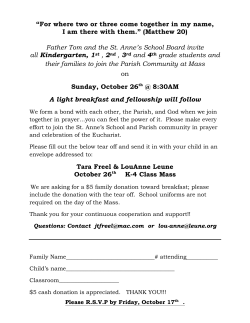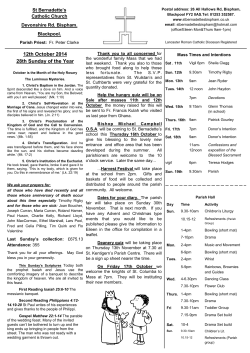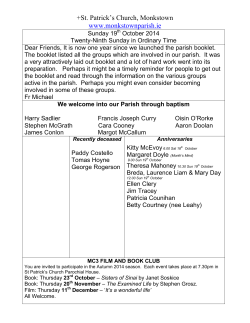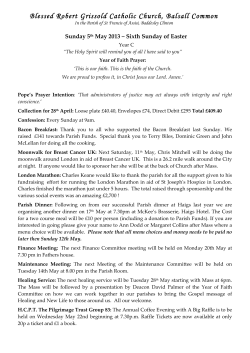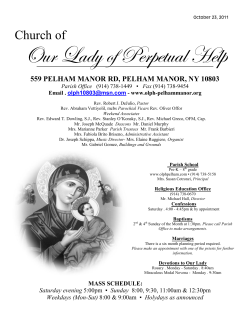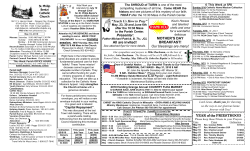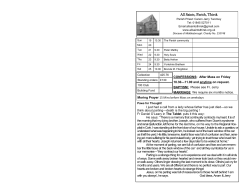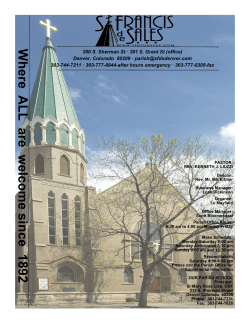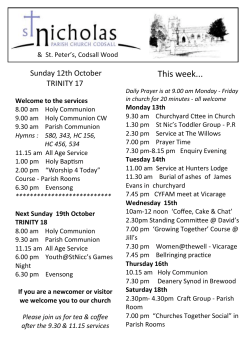
Thriplow Journal Vol. 20/3 Spring 2012 Editorial
Thriplow Journal Vol. 20/3 Spring 2012 Editorial They seemed like oxen, Ploughing white fields, Holding a white plough, Sowing a black seed. Riddle of Verona, 9th century * I found this ancient riddle fascinating, the answer is ‘Writing’ – the oxen are the fingers holding the pen, the plough is the Goose Quill, the white field is the parchment and the black seed is the ink. In the days when all writing was by hand, it was important not to dig the quill into the paper too deep or it would stick. It is easy to imagine writing in a straight line was as important to the scribe as ploughing in a straight line was to the farmer. These days the analogy to typing on a keyboard is more like dropping individual seeds into the seeddrill. This edition of the Thriplow Journal is our 60th. We will be binding these 60 Journals, probably in two volumes with money from the Daffodil Weekend Trust, so that our writings will be preserved for future Thriplow people. We are very grateful to all of you who have written your research, memories and thoughts and hopefully we will be printing more of your work in the coming years. An invitation to all members to our 20th Birthday Party is elsewhere in this Journal, please come. Let Shirley or any of the Committee know if you would like a ticket, (it is by invitation only) and also so that we know how many to cater for. Committee members’ telephone numbers are on the back of your programmes. Due to lack of space two articles have been held over until the next edition. Angela Rimmer and Shirley Wittering, Joint Editors. NB. Subscriptions (£6) are due in April. * The Marks in the Fields, Eds. R G Dennis & E Falsey, The Houghton Library, Harvard University, 1992 GARDENER AND SPADE TO GREEN MAN The history of Thriplow’s last public house. This is a reprint of an article written by Geoffrey Axe and first published in the Thriplow Journal in 1998. We are reprinting it to highlight the need to preserve the last remaining pub in Thriplow. As a village we are extremely fortunate to have a Shop, a Pub, a School and a Church, all establishments which contribute to a sense of Community. It would a shame to loose even one of these. THE GREEN MAN The history of the Green Man can be researched in documents held in Cambridgeshire Record Office, Shire hall, Cambridge. These include; newspapers - the Cambridge Chronicle, Herts. and Cambridge Reporter; the Licensing Returns; Kelly’s Directories; and Census Returns. The first record indicates that the place was called the Garden and Spade from 1788 to 1793. It then changes to the Gardener’s Spade from 1794 to 1797. And then to Gardener’s Arms from 1798 to 1799. It then changes back to the Gardener’s Spade in 1800 to 1821. In 1822 it became the Green Man. The property originally belonged to Bacon’s Manor and in 1657 is recorded as ‘1 messuage with orchard and garden and 3½ acres arable land, rent 5/-.’ It was leased to various tenants and by 1785 it had passed into the hands of one John Chapman, Victualler, then William Beldam of Royston, Common Brewer then John Phillips brewer also of Royston who bought it for £290 in 1839. There is a mention of an auction at this public house in the Cambridge Chronicle dated 9th of May 1795, which quotes the following: To be sold by auction on Tuesday the 19th of May at the house of Mrs Chapman, known by the sign of the Gardener’s Spade, at Triplow, between the hours of 3 and 5 in the afternoon, subject to such conditions as will be then produced, a freehold cottage. An interesting record about the Gardener’s Spade is displayed in the Square and Compasses public house in Gt. Shelford. This record is in a picture frame hanging on the bar wall. It quotes that in 1815 Mary Chapman was the licensed victualler with a new public house at Triplow for Messrs Phillips. In the Cambridgeshire Record Office there is some interesting information on the Green Man, contained within some old notebooks of Crocket and Nash. Surveyors. They quote, April 15th Estimate of sundry work proposed to be done in rebuilding a public house in Triplow. At a cost of £190. Another entry on 26th. April 1822 shows an estimate for intended work in rebuilding, including ‘digging the walls; brickflat floor & filling in trammings 6” above present surface; addition to kitchen & living room; passage under stairs; dairy, cellar (where is it now?), bakehouse, chimney in bedroom and window in back bedroom’. . The final costs including the labour of plasterer; smith; mason; plumber; slater; bricklayer; joiner and painter & glazier come to £400. On 11th. July of the same year there is more work done and the final total is £1,150-9-0. In May of the following year Wm French is paid £109.for brickwork and plastering in the Club Room floor. The public house is mentioned again on a sale-poster from the Cambridgeshire Record Office which quotes: That at the Green Man, Triplow next Tuesday, June 3 1828 at 7pm. in one lot. Freehold dwelling house and close of pasture is to be sold by Auction by Elliot Smith. The next mention of the Green Man is in the 1841 census where a William Gambie (aged 40 yrs) is quoted as being the publican. He is mentioned in the 1847 Cambridge Post Office directory as being a beer retailer, but there is no mention of the name of the public house. The 1851 census shows there’s another William Gambie (aged 30 ) as the publican of the Green Man with his wife Rebecca (aged 28 ) and his two sons James (aged 2 ) and Phillip (3 months old). William Gambie is listed again as the licensed victualler of the Green Man in the History Gazetteer of Cambridge 1851. In the 1864 Cambridge Post Office Directory James Huddlestone is mentioned as the publican of the Green Man. He’s also mentioned in the P.O. Directories of 1867 and 1869. And in the census of 1871, which gives his age as 39 yrs old with his wife Elizabeth (aged 42 yrs) and three sons Charles (aged 16) Frederick (aged 14) and Albert (aged 7). On June 1st 1872 an inquest was held at the Green Man. The following report appeared in the Cambridge Chronicle: Inquest-. On Tuesday C. W. Palmer, Esq. , Deputy Coroner held an inquest at the Green Man, concerning the death of Azubah, wife of William Flack, labourer. Mr. Carver, surgeon who made a post-mortem examination of the body, said that death resulted from inflammation of the bowels and disease of the heart; and a verdict to the affect was recorded. The deceased was 42 years of age. James Huddlestone continues to be mentioned in Kelly’s Directory of 1873 and 1876 as the publican of the Green Man. Then in 1878 his name appears in the Herts & Cambs Reporter where the following quote appears under the Melbourn Petty sessions section, in an application for renewal of the annual licence : The Green Man, Thriplow In the case of the license of the above house at Thriplow, held by James Huddlestone, Mr. Stretten had given notice to the holder of the license of an objection being made at the present meeting against his license being renewed. The notice set forth that Huddlestone was an unfit person to hold the license from his having, when goods were offered to him at very much under value by one Walter Morley, and which there was every reason to believe might have been stolen, expressed his willingness to purchase the same, and would have done so except for the interference of his wife; and also that he concealed and denied that the said goods had been offered to him until he was informed that one of the persons had confessed the robbery, and that he (Huddlestone) had offered to purchase the goods. Mr. C.W. Palmer, solicitor of Cambridge, appeared for Huddlestone, and submitted that the notice was bad in law. The objection, however, was eventually waived, and Mr. Stretten, in support of the facts stated on the notice, called Police-sergeant Levitt, of Chesterton, who said that in February last he received information of a robbery from Thriplow of a quantity of wheat. He went to Duxford and found the men suspected and charged them with stealing it. From what was said to him by the prisoners he called upon James Huddlestone, of the Green Man, Thriplow and told him that he (witness) was informed that a sack of wheat had been stolen from Mr Webster’s premises at Thriplow and that the wheat had changed hands at or near his (Huddlestone’s) house. He replied that he saw nor heard nothing of the wheat. In company with Huddlestone witness looked round the yard but saw nothing of any corn. On the following day February 25th, witness had further communication with the prisoners, and from what they said he went to Thriplow and saw Huddlestone again. He said to Huddlestone then, ‘These prisoners have made a very strong Implication against you. One of them said it was offered to you for sale by Walter Morley.’ Witness told him he thought as he was a licensed man he had better tell him the truth about it. He replied that he would do so, and said that Walter Morley came to him as he was drawing beer in his cellar and asked if he would buy a sack of wheat, to which he (Huddlestone) replied, “I have made up my mind to buy anything worth the money.’’ Huddlestone: “In a straightforward way,’’. Witness (continuing) said Huddlestone told him that he asked Morley the price of wheat and he said 7s. and that he should have bought it only his wife came up and he should not buy it for anybody. He never saw the wheat. The Clerk, referring to the circumstances of the robbery, said he believed the prisoners were brought up to that bench and dealt with summarily, and that no charge was preferred against Huddlestone. Sergeant Levitt said that was so, Huddlestone was called as a witness by Deputy Chief Constable Stretten: ‘Huddlestone did not say anything to me about it until I told him that the prisoners had confessed to stealing it and to offering it to Huddlestone for sale’. Mr. Palmer: ‘were you present when the prisoners were convicted?’ Witness: ‘I was, they pleaded guilty’. Mr. Palmer: There was not a single word said against Huddlestone upon that matter in Courtthey made no statement in the Court against the applicant at all?’ Witness: ‘No. I have resided in this (Melbourn) district for several years. I am not aware that any complaint has been made against Huddlestone’. Mr. Palmer said there was no proof that “he would have purchased it” as set forth in notice, and he took it that the clause in the notice was abandoned by Mr. Stretten. Mr. Stretten said he did not abandon it at all. If a man offered to do a thing it was a matter of inference as to whether he would do it, and that must be left to the Bench to decide. Mr. Palmer submitted to the Bench with confidence that there was nothing in the evidence adduced to justify them in withdrawing this man’s certificate. These prisoners plead guilty of having stolen the corn. They did in all probability offer it to his Client, but he did not purchase it; and the prosecution was so satisfied with his respectability that they actually would have called him as a witness to prove the case against these men had not they pleaded guilty. While as to the statement of the corn changing hands at Huddlestone’s, the witness searched the premises and could find no traces of this having been the case. Then they had to look at the character of a man who had conducted his house for 17 years in a respectable manner, and never had any charges brought against him. Upon this matter coming to the knowledge of Messers. Phillips, the owners of his house, they gave him (Huddlestone) notice to quit, but upon subsequent inquires they considered him a proper man to conduct the house, and therefore, subject to the magistrates decision now, did not propose to put the notice into force. In addition to this he had a testimonial from the clergyman of the parish as to the character of his client, which, utterly unsolicited, was sent to the owners of the house in consequence of the notice to quit. Mr. Palmer then read a letter from the Rev. J. Watkins, Vicar of Thriplow, in which that gentleman stated that from what he had seen and heard of him (Huddlestone) during the last 4 years he considered him to be very respectable and hard working. He conducted his businesswhich as well known was always a difficult one in as honest and straight forward a way as was possible among people who were liable to drunkenness, as Thriplow people unfortunately were. (laughter). With regard to the question of the corn he (the writer) believed him to be entirely innocent. He should be the last to defend a publican against whom he knew any real ground of the complaint; and it was in the interests of justice both to the tenant and to the owners of the house that he had written a letter. Mr. Stretten said he admitted all that had been said, and would go even further in speaking of the good character borne by the applicant during the time he had conducted his house, but it was his duty to lay the facts concerning the conduct of the houses in the division before the magistrates from year to year, and that was his only object in bringing the case before them. The magistrates then retired, and on their return the chairman said they were unanimously of the opinion that there was no case to justify them in withholding the license, and that it was the opinion of the whole parish of all ranks that he was a most respectable man as publican. At the same time it was the duty of the police not to refuse any information they could get. The license was granted as usual. In Kelly’s Directory of 1879 James Huddlestone is listed as the publican of the Green Man and this is confirmed in the 1881 census. It lists James Huddlestone as publican of the Green Man (aged 49 yrs) with his wife Elizabeth (aged 52 ) with one son Richard a scholar (aged 7 ) and one daughter Ruth (aged 4 ). In Thursday 20th. April 1882 an inquest is held at the Green Man and reported in the Cambridge Chronicle on the death of Elizabeth Fuller aged 2 yrs and 7 months. In the following year the same newspaper quotes the following: June 23rd. 1883 Suicide - On Tuesday, at the Green Man public house, Mr. C. W. Palmer, County Coroner, held an inquest touching the death of Wm. Bush, aged 70, bailiff to Mr. Perkins.- It appeared that the deceased, since the death of his wife, 2 years ago, had lived by himself. For a fortnight or so prior to Friday, the April 8th, he had been in a depressed state of mind. During Friday, the deceased had some refreshments at a neighbour’s house, where he said his poor head was very bad, and when it was suggested to him that the Doctor should be call on him, he said that “there was no telling where he should be”. He was missed from his home on Friday evening, and on the Saturday was found lying in a neighbouring field. A four chambered revolver, with 2 chambers empty, was lying close by, and the deceased had apparently shot himself. He was however, alive. After being taken home he admitted he had done wrong, but assigned no reason. He had been in the habit of keeping the revolver by his bedside. He died on Monday last Mr. Earle, surgeon, gave evidence showing that the death resulted from a bullet wound in the head, and said that judging from the position of the wound and the state of the ear, he believed the wound was self-inflicted.- Verdict, “suicide while of unsound mind”. In Friday May 29th 1891 there is a report in the Royston Weekly News that quotes an inquiry that was held in the Green Man on the death of Emily Hannah Freeman aged 4½ who had died from scald caused by pulling a frying pan over herself.. The jury found the verdict of “Accidental Death” James Huddlestone continues to be mentioned as a publican until 1896. Then in Kelly’s Directory of 1900 James Brookman is mentioned as publican of the Green Man. By 1903 the Arrington & Melbourn Petty Sessions Division quotes that a Ernest Edwin Wooster was the publican of the Green Man; it also shows that his other occupation was a labourer and that the pub was most used on Fridays and Saturday nights. Other information quotes the rateable value which was £17 a year. The size of property (3 bedrooms, 2 public rooms, 1 stable, front & back entrance and a 1 W.C). The class of Licence is shown as being a tied alehouse belonging to Phillips & Company, Royston, Herts. By 1904 Charles Smith is quoted in Kelly’s Directory as publican of the Green Man, he is also a farmer and carter Again his name is mentioned in Kelly’s Directory of 1908. Then there’s a gap of 7 years before William Robinson appears at the Green Man; his name is quoted in the 1915 polling records for the parish of Thriplow. His name is also mentioned in the Kelly’s Directories of 1916, 1922, 1926, 1929 and 1933. The last Kelly’s Directory from Cambridgeshire, in 1937, quotes Percy Charles Buckerfield as publican of the Green Man. And the polling records show he remains there until 1950. He was Kath Pettit’s father, (see Journal Vol.3/1) The Green Man closed in 1992. Shirley Wittering and her daughter Polly painted the daffodils to cheer up the visitors to Daffodil Weekend. The following list of publicans of the Green Man names and dates come from the Parish of Thriplow polling records Alfred George Wilson from 1951 to 1951. Derek G. Rhone from 1951 to 1956. Thomas Hodeson Boyle from 1956 to 1967 Reginald Charles Francis from 1968. William Flint from 1969 to 1969. Reginald Charles Francis from 1970 to 1972. Margaret Francis 1973 to 1975. Robert Andrew 1976 to 1976. Derek Corben 1977 to 1983. Val Elliot 1984 to 1991. Val Elliot died of alcoholic poisoning in September 1991. The Green Man had been closed since the previous May and the Brewers, Charles Wells, wanted to sell it off as a house with planning permission for another house in the grounds, but pressure from locals prevented this and it was bought by Lawrie Childs and Roger Ward of the Bees in the Wall in Whittlesford. It then became a Free House and today is under the sole ownership of Mary Lindgren. Footnote In 1961 Flowers Breweries Ltd. sold the Green Man to Charles Wells, brewery of Bedford. There are some chronological gaps as to who was the publican/landlord at different periods as unfortunately the records are not consistent. Geoff Axe The Green Man 1991 The Green (Blue!) Man under Mary Lindgren 2009. The Recreation Ground A group of mothers have approached the Parish Council with a view to reinvesting in the Thriplow Village Playground. The group, called the Thriplow Rec Improvement Committee, or TRIC for short, aims to raise funds from a variety of sources and to consult widely so that the improvements can be afforded, and are relevant to the needs of the users and to the neighbours of the play area, indeed to everyone in the village. The Parish Council is supporting the aims of the group, and has established the group as an Advisory Committee to the Council. Two councillors have been attached to TRIC. The money has now been raised and the refurbished Recreation Ground will be opened by early Summer 2012. * The Recreation Ground dates from 1846 when the village was Enclosed by Act of Parliament. Previous to enclosure the villagers were allowed to use the Moor which was situated between Thriplow and Whittlesford and covered an area of 180 acres. This map shows the Moor before enclosure. In the Enclosure Award of 1846 the Enclosure Commissioners stated: ‘We the said Commissioners in further pursuance of the directions of the said Act have set out and allotted and do hereby award and confirm unto and for the Churchwardens and Overseers for the time being of the said Parish of Thriplow as a place of exercise recreation for the inhabitants of the said parish the two following plots of land that is to say:First Allotment – One plot of land called the Green containing two acres one rood and eight perches bounded on all sides by ancient inclosures and the ends of public roads. Second allotment - Also one other plot of land in Westfield containing two roods and thirty two perches bounded on the north east by ancient inclosures of Joseph Ellis, George Coleman and Henry Perkins respectively on the south east by the Foulmire Road on the south west by an allotment to Joseph Ellis and on the north east by an ancient inclosure of the said Joseph Ellis the fences of which said allotment against the said road shall be made and maintained by the said Churchwardens and Overseers for the time being of the said Parish of Thriplow.’ Enclosure map showing the Green and the Recreation Ground, 1846. This piece of ground was given to the Parish as a place of exercise and recreation for the inhabitants of Thriplow in 1846 when the village was Enclosed by Act of Parliament. Previously it had been part of West Field and used for agriculture. The responsibility of caring for it was invested in the Overseers and Churchwardens; in 1894 the Local Government Act resettled the responsibility for the land from the Churchwardens and Overseers to the newly formed Parish Councils. An interesting result of the relatively small amount of land set aside for the use of the villagers in Thriplow, was that the ‘labourers of Fowlmere’ petitioned Parliament in 1845 when that parish was thinking of enclosure, to appeal for more land stating that:- ‘When they enclosed Thriplow the adjoining parish to us, they left not a single foot of the extensive commons for the use of the poor with the exception of the recreation ground.’ They went on to say that they had 20 acres of common land allotted to Spade Husbandry for the poor to occupy and were fearful of losing it. As a result of this petition, Fowlmere was awarded 28acres of Spade Husbandry land and a Recreation Ground of 3 acres. Even then they complained that 3 acres was not really big enough for a cricket meadow. * Quoted from the Thriplow Web Site NB. Spade Husbandry was a system introduced in the reign of William IV to encourage the poor to grow food for themselves. They were not allowed to use any mechanical means of tilling the soil except hand tools and were charged a minimal rent. The Fowlmere Overseers charged 2d per pole. A pole measures 5.5 yards or 5.3 metres. Shirley Wittering Trees of Thriplow 11 – Spindle Tree The Spindle Tree (Euonymus europaeus) gets its name from the days before spinning wheels when spinning was done by spinsters on spindles. It is more of a bush about 15' high though it can become a small tree about 25' high. It is not common in Thriplow; in fact I only know of two places where it can be seen, one is alongside the old Icknield way in Newditch Plantation and the other is my back garden. Its attraction is its fruits which it produces profusely in small bunches. When ripe they consist of four bright pinkish-red capsules which open to disclose four bright orange-coloured seeds. These seeds are an emetic; it is wise therefore to teach children not to eat them. The shrub is very attractive in the autumn when its leaves turn a deep red. Its main uses are for wooden knitting needles, butchers skewers; made into clothes pegs by gypsies and into high grade charcoal for artists. In former times, its leaves and seeds were dried and powdered and dusted on children to drive off lice. Bill Wittering You are invited to the Thriplow Society’s 20th Birthday Party On Thursday 19th April 2012 (and AGM) Quizzes, competitions, raffle and cold buffet If you would like a ticket please tell Shirley Wittering 01763208269, Shirley.wittering@btinternet.com Thriplow Manor Growth and Decline Part II Fig 1 View from South In my first article (printed in the last Journal) I described the family of farmers that had lived in the house from the late 18th to the early 20th Centuries. The house and surroundings are in many ways as they left it; from hooks where the farm labourers would have hung their coats on the top floor, to the signature scratched with a diamond by William Clark the first of the farming family, on what would then have been the window of the Farm kitchen. In 2010 we were visited by Ralph Gillis; Ralph is a USA lawyer who is a visiting fellow at Jesus College, his Mother was a Barrington, and he was tracking down the history of his family. From the 21st C, we were taken back to the 11th C and perhaps a little earlier. In1228, during the reign of Henry the III the property was acquired by Nicholas de Barrington. The property was sold by Thomas Barrington to Richard Prime in 1581 during the first year of the reign of Queen Elisabeth I. A little background; the Barrington’s, a Norman family, first appear in English history as members of the court of Emma, Queen of England. Emma was not English, but a Norman princess, in fact, the sister of the Duke of Normandy. She was married first to Ethelred the Unready, described as idle, witless and cruel who came to the throne in 975, and then to Canute, a Danish King, and excellent ruler. After the death of Canute and his sons, the crown passed to Edward the Confessor. Edward had spent twenty seven years in Normandy, so the links between the English, the Normans and indeed the Danes was close and complicated. Edward was a devout man whose greatest interest was the building of Westminster Abbey. The Saxon Earl, Harold Godwinson and previously his father, ran the country very effectively during Edward’s reign, and he was the obvious choice as king. I have often wondered if the Barrington’s were involved in a little regime change round about 1066, confirming their Norman friends in power, rather than the Saxon, Harold. After the Conquest, the Barrington family operated at the highest levels of the Norman administration; Ralph de Barrington was a member of the Doomsday Jury in 1086 and would have been well aware of the charms of Thriplow. The Barrington’s were a powerful family, but clever enough to keep their heads just below the parapet. For the next seven hundred years, they owned many estates, and may never have set foot in this house. However, documentary evidence indicates that some members of the family did indeed live here. The details of the Thriplow Hundred are recorded in the ‘Retuli Hundredorum’ of 1279. It confirms that Agnes de Barrington held 120 acres as the feudal tenant of the earl of Essex, and that she had the right to escort the Earl of Hereford round the boundaries of the village. The meaning of these feudal privileges has been lost in the mists of time. Some time ago I discovered that some members of the British Nobility have the right to sit in old Palace Yard next to the Houses of Parliament - the relevance of this feudal privilege even defeated House of Lords Clerks. Thomas Barrington passed the title of the house to Richard Prime in 1560. So the Barringtons or Barrentons held the property for three hundred years and their name was forever associated with the property until Geoffrey Vinter changed the name in the 20th C. The Barringtons acquired the House from the family recorded in Doomsday book, Sigar the Server of Algar the Staller (or Steward). The name may be Danish. Danish families invested the pay off (Dane Geld) from Ethelred the Unready in land in South East England (but continued their Piracy!). They may have built the first House with money paid to them to promise not to ravage the countryside. They must have had a good relationship with the Normans if so this might explain why they still held the manor in 1279. It was quite rare for an English or Danish family to hold a property when the Normans were consolidating their position as rulers of the country. I am sure more work could be done to establish identities, but so many Anglo Saxon sources are lost for all time. It is likely that the Barringtons acquired the property legally as at the time, Henry the First was codifying English law, on the basis of the old Anglo Saxon laws, and had ruled that courtiers found guilty of stealing property, could be sentenced to mutilation, or death (tough times). Turning back to the house; is it possible to form a view on how it looked through the ages and how the owners lived? Viewed from Middle Street the house looks like typical Tudor Hall house. Viewed from the South it is quite different, a mixture of wings and a tower, parts added and perhaps bits missing. Inside the ground floor of the present house the main part is indeed exactly what we see from the road; a rectangular format with perpendicular studs and a large chimney in the centre, with two hearths. The structure of the ground floor is earlier than Tudor, and at some point the upper story and chimney were added. These works would have been carried out by the Barringtons. The house was subsumed into a mansion built by Richard Prime during the reign of Queen Elizabeth 1. Prime added three wings, a large southern wing and two smaller wings. At this time the house was approached by a drive from the junction of Middle Street and across a bridge over the moat (that we have restored). The large wing was demolished at the end of the 18th C and the house converted to a farm. A brief word on the name of the House, we purchased it as Thriplow Manor. For most of the period when it was owned by the Vinter family, it was known as the Manor House. In the 19 th Century it was called Barentons Manor Farm, and for most of its life it was Barentons Manor. To which name it should ideally return. So in summary, the Saxon and early medieval house Fig.2 would have been single story with a raised floor, the solar, this would have been the living quarters of the lord, in the hall area, the servants and some animals would have slept round an open fire with the smoke escaping though the roof. Figure 2 Early Medieval House A fire stone still exists under the floor boards of the ground floor. The Saxon house may have had the same floor plan as the medieval house and the Saxons could have warmed themselves round the fire on the remaining fire stone. The house would have remained in this condition until some time in the medieval period when the upper floor was added, and in the 15th century the chimney. Given time and effort it should be possible to unravel this jigsaw with more precision. The acanthus leaf surround now hidden under later additions, could be dated, as could the timbers to determine the stages of development. The carpenter’s marks that were used to assemble the house are visible in what is now a wine cellar. The steps to the side entrance of the house are not accessible, but hidden in a space under the room now used as a library. The later medieval house may have had windows as shown, but for most of its life it would have timber slots. The layout is shown in figure 3 Figure 3 Barrington’s House The rebuilding of the house by Prime was at a time of growing rural prosperity and when a great rebuilding of properties across England took place. New glass technology from the continent allowed large windows to be installed. Prime must have been very proud of his new house, and installed a fine timber beam in the hall floor recording the event. Most of the ceiling is hidden by Victorian plaster, but it would greatly enhance the room if this wonderful ceiling could be exposed. Figure 4: ANO*DNI*1563*R*E*REGINA In the year of our Lord, 1563, in The Reign of Elisabeth the Queen In the same room the Tudor fireplace was uncovered and restored by Vinter. To the left of the fireplace a carved portcullis is let into the wall. This is certainly not Prime’s work, and looks suspiciously like a remnant of the old Houses of Parliament, destroyed by fire in 1833 (or the Bombed House of Commons and installed by Vinter) Figure 5: Fireplace The Hearth Tax of 1674 recorded the house as having seven hearths; this would tie neatly with the three that remain, the demolished wing would have had two large chimney stacks with four hearths. The outline of Richard Primes House is shown in figure 6. The outline of the wing is reasonably clear; it would have stood over a cellar filled in after the last war. It is reasonable to assume that its elevation would have matched the existing wings. The sketch shows how Prime’s mansion might have appeared at the time of Sir Christopher Hatton. We know that he built the walls and the walled garden; I have stretched imagination a little further and assumed that Dame Elisabeth required that the front of the house was given a fashionable upgrade to match Sir Christopher’s Italianate gardens . Figure 6 Richard Primes Mansion In 1672 the house was purchased by Christopher Hatton, he did much in his comparatively short tenure to improve the gardens, building the walled garden, and the walls that line Middle Street. He almost certainly purchased the house to help fulfil his duties at the University. In 1681 he sold the house to Dr Humphrey Gower the Master of St John’s College. On his death it passed to his cousin Mr West, and on his death and according to the terms of Dr Gower’s will it reverted to the Masters of Johns College, at which point it slipped into irrecoverable decline. Sadly at the end of the 18th Century the house fell into disrepair, the main wing was demolished and the rest converted to a farm house by a well known architect. However no trace of designs or record of his work was found in his papers or records of John’s College. I have tried to find clues as to how this sorry state of affairs came to pass. I have found some clues as to why the property was allowed to decline. The 17th and 18th centuries were extremely difficult times for the clergy, allegiance to the monarch and conforming to the currently fashionable doctrine was vital to survival and success. Christopher Wren’s uncle, Bishop Wren, was imprisoned in the Tower of London for years. Wren was most careful to stick to mathematics and architecture. The ditty the ‘Vicar of Bray’ could have been written by a recruitment consultant as a formula for success in the established church of the time. The Master who followed Dr Gower was Dr Robert Jenkin; he was unfortunate to be a cleric and Master at the accession of William 4th. He felt unable to switch allegiance and this cost him his clerical posts but he retained his post as Master of Johns. The loss of the clerical posts would have had serious impact on his wealth, as church stipends were substantial. His health declined and he died in 1727 in the care of his family in Kent. It is just a guess but entirely possible that the wealth of the college declined as did the interest of the Masters in using the house. Records in St Johns College show a great caution in making funds available for maintenance and a decision not to maintain the pigeon loft. Be that as it may, in 1770, the house was converted to a farm. The farm was virtually the same as the Barrington’s medieval house, figure 7, it retained the two south wings and a dairy was added mid 19th C. The barns and farm buildings are now lost. Fig 7 Farm House In 1945 Geoffrey Vinter added an extension, with a tower staircase converting the second floor into an independent apartment, and together with other minor extensions brought the dairy into the house as a kitchen, together with the conversion of outbuildings as utilities and boiler rooms. We have carried out considerable restoration, and completely replaced the stable block with garages, and workshops. Work on the garden goes on for ever. The Medieval Bridge was discovered and restored. The remnants of Hatton’s Garden have been restored, gates replaced and restored. The moats have had much restoration work, and have in places been lined so they hold water throughout the year So remarkably this small house may well have parts that take us back a thousand years to the Saxons or Danes, the wooden walls and fireplace of the Barringtons small but elegant medieval house, Richard Prime’s magnificent timber ceiling, the farmhouse kitchen and dairy, and Geoffrey Vinter’s additions to create a pleasant dwelling for modern living in the then fashionable Arts and Crafts style. That brings us to the present day where we fight to stop it falling down. For other brave souls that enjoy living in such a property we have found being members of the Society for the Preservation of Ancient Buildings invaluable as has been advice from conservation officers in South Cambs District Council. Michael Braithwaite A Farming Dynasty Philip Pumfrey – 5 April 1928-12 October 2011 Philip Pumfrey was born in Duxford into a farming family; he moved to Thriplow in 1938 with his two brothers – Richard (Dick), Harold and a sister Margaret in 1935. The family, headed by their father Sidney Pumfrey, farmed 1,500 acres in Thriplow centred on Manor Farm and Cochranes. His brother Robert (Bob) complimented all this at Temple Farm, Duxford and also controlled the heavy haulage steam engines used for threshing and deep cultivation. Philip, a friendly and charming individual, quickly became integrated in the village life including becoming a chorister and server at the village church. The whole family could be relied upon as contributors to the village life and activity in addition to employing in excess of 50 people. The farming group included up to 30 working horses and cattle and a large sheep flock in addition to the 50 odd permanent employees. Casual labour was required generally for sugar beet and potatoes and sometimes to assist during grain harvesting. Very often these were well skilled Irish groups. Number of labourers on the various Thriplow farms and smallholdings: Pumfreys (Manor Farm) 50 (previously called St John’s College Farm) Bacons 25 Mr Smith Dellers (Rectory Farm) 10 Perrins (Foremans) 3 Parker’s Winter Egg Farm 10 (Thriplow House) Freemans Middle St. 2 (Dairy House) Total 100 The farming area is now covered by Thriplow Farms and Russell Smith Farms who together employ approximately 10 permanent employees. The Pumphreys sold up in 1947. Philip’s passing prompted many memories and a fairly dramatic incident on August 12th 1944 when a Mustang Aeroplane (from Fowlmere Airfield) crashed on to the cattle yard at Manor Farm next to the house, killing an animal, and the poor pilot; this was witnessed by Margaret Pumfrey, who remembers the fire and the heat cooking the apples on a nearby tree. As it was wartime, compared with the present time, this incident caused very little outside interest, no media coverage, police attention or road closures. The village dealt with it and carried on in their own way! Margaret Pumphrey harvesting with Traction Engines in Thriplow 1938 Bill Smoothy, ‘Soot’ Smith and George Moule on a new Bailer, August 1940 Michael Moule Gleanings In Memoriam – We were very sorry to hear of the death of George Sheldrick on February 24th 2012 aged 89. We reviewed his book in the last Journal. When Bill retired George persuaded us to come to his Ballroom and Sequence Tea Dances which he held in Newton Village Hall then. The hall soon became too small and we moved to Harston Village Hall where at one time, there would be 80 people dancing; we loved it and became quite proficient at all the different sequences. We shall miss his cheerfulness and skill at building and repairing traditional buildings and offer our condolences to Hilda and his family. George Sheldrick unveiling a plaque in Fowlmere in memory of VE/VJ Day 1995 The next meeting, our AGM, is also our twentieth birthday and all members are invited to a party on Thursday April 19th. A buffet, competitions, a Best Home-Made Hat competition and a raffle. If you would like an invitation please let Shirley Wittering, 01763208269, know by April 12 th as we need to know numbers for catering and we will give you a ticket. Entry is by ticket only. Thank you to all those who helped put up the gazebo, displayed the exhibition and stewarded the Smithy over Daffodil Weekend. Geoffrey Axe, David Easthope, Peter Yates, Michael Moule, Bill and Nick Wittering, Angela Rimmer, Jean Tomlinson, Hanna and Brian Roberts, Judy Murch and Anthony Cooper. Thanks also to our two wonderful Blacksmiths, Simon Teale and Peter Allen. Thanks to Anthony Cooper for the gift of a 1903 OS 6” map of Thriplow. Thriplow Jubilee Celebrations Advanced notice – a small committee have formed to plan some special events in the village to celebrate our Queen’s Diamond Jubilee. These will be held on Sunday June 3rd 2012, in and around the village. There will be childrens’ and adults’ games and competitions, a parade, bouncy castle, music and entertainment in the evening, combining with the usual annual village barbeque. The smithy will be open too. More information will be published in the coming weeks so do please put the date in your diary. Thank you. Back cover The glass trophy for the Queen’s Award for Enterprise in its new position in the Village Hall
© Copyright 2025
